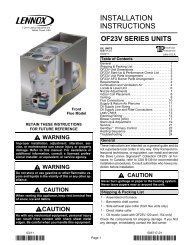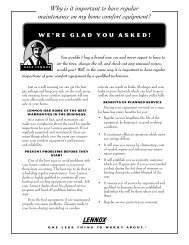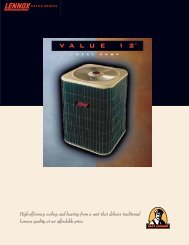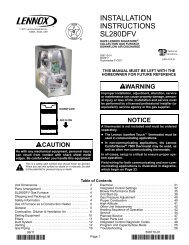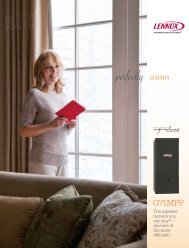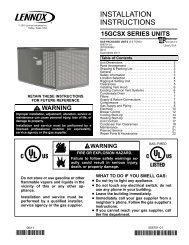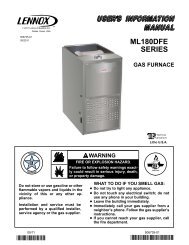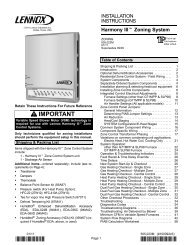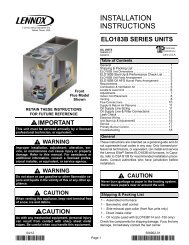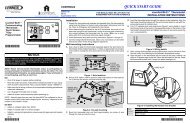ML193DF Gas Furnace Installation Manual - Lennox
ML193DF Gas Furnace Installation Manual - Lennox
ML193DF Gas Furnace Installation Manual - Lennox
You also want an ePaper? Increase the reach of your titles
YUMPU automatically turns print PDFs into web optimized ePapers that Google loves.
TABLE 14<br />
Conversion Kit and Pressure Switch Requirements at Varying Altitudes<br />
ML193<br />
Unit<br />
Natural to<br />
LP/Propane<br />
0 − 7500 ft<br />
(0 − 2286m)<br />
High Altitude<br />
Natural Burner<br />
Orifice Kit<br />
7501 − 10,000 ft<br />
(2286 − 3038m)<br />
LP/Propane<br />
to Natural<br />
0 − 7500 ft<br />
(0 − 2286m)<br />
High Altitude<br />
LP/Propane<br />
Burner Orifice Kit<br />
7501 − 10,000 ft<br />
(2286 − 3038m)<br />
High Altitude Pressure<br />
Switch<br />
4501 − 7500<br />
ft<br />
(1373 −<br />
2286m)<br />
7501 −10,000<br />
ft<br />
(2286 −<br />
3048m)<br />
−045<br />
−070<br />
−090<br />
*69W73 73W37 *73W81 *68W68 74W90 74W91<br />
−110<br />
* Conversion requires installation of a gas valve manifold spring which is provided with the gas conversion kit.<br />
Pressure switch is factory set. No adjustment necessary. All models use the factory−installed pressure switch from 0−4500 feet (0−1370 m).<br />
Testing of Non−Direct Vent Applications<br />
for Proper Venting and Sufficient<br />
Combustion Air<br />
WARNING<br />
CARBON MONOXIDE POISONING HAZARD!<br />
Failure to follow the steps outlined below for each<br />
appliance connected to the venting system being<br />
placed into operation could result in carbon monoxide<br />
poisoning or death.<br />
The following steps shall be followed for each appliance<br />
connected to the venting system being<br />
placed into operation, while all other appliances connected<br />
to the venting system are not in operation.<br />
After the <strong>ML193DF</strong> gas furnace has been started, the following<br />
test should be conducted to ensure proper venting<br />
and sufficient combustion air has been provided to the<br />
<strong>ML193DF</strong> as well as to other gas-fired appliances which<br />
are separately vented.<br />
If a <strong>ML193DF</strong> furnace replaces a Category I furnace which<br />
was commonly vented with another gas appliance, the size<br />
of the existing vent pipe for that gas appliance must be<br />
checked. Without the heat of the original furnace flue products,<br />
the existing vent pipe is probably oversized for the<br />
single water heater or other appliance. The vent should be<br />
checked for proper draw with the remaining appliance.<br />
The test should be conducted while all appliances (both in<br />
operation and those not in operation) are connected to the<br />
venting system being tested. If the venting system has<br />
been installed improperly, or if provisions have not been<br />
made for sufficient amounts of combustion air, corrections<br />
must be made as outlined in the previous section.<br />
1 − Seal any unused openings in the venting system.<br />
2 − Visually inspect the venting system for proper size and<br />
horizontal pitch. Determine there is no blockage or restriction,<br />
leakage, corrosion, or other deficiencies<br />
which could cause an unsafe condition.<br />
3 − To the extent that it is practical, close all building doors<br />
and windows and all doors between the space in which<br />
the appliances connected to the venting system are located<br />
and other spaces of the building.<br />
4 − Close fireplace dampers.<br />
5 − Turn on clothes dryers and any appliances not connected<br />
to the venting system. Turn on any exhaust<br />
fans, such as range hoods and bathroom exhausts, so<br />
they will operate at maximum speed. Do not operate a<br />
summer exhaust fan.<br />
6 − Follow the lighting instruction to place the appliance<br />
being inspected into operation. Adjust thermostat so<br />
appliance will operate continuously.<br />
7 − Use the flame of match or candle to test for spillage of<br />
flue gases at the draft hood relief opening after 5 minutes<br />
of main burner operation.<br />
8 − If improper venting is observed during any of the<br />
above tests, the venting system must be corrected or<br />
sufficient combustion/make-up air must be provided.<br />
The venting system should be re-sized to approach<br />
the minimum size as determined by using the appropriate<br />
tables in appendix G in the current standards<br />
of the National Fuel <strong>Gas</strong> Code ANSI−Z223.1/NPFA 54<br />
in the U.S.A., and the appropriate Natural <strong>Gas</strong> and<br />
Propane appliances venting sizing tables in the current<br />
standard of the CSA−B149 Natural <strong>Gas</strong> and Propane<br />
<strong>Installation</strong> Codes in Canada.<br />
9 − After determining that each appliance remaining<br />
connected to the common venting system properly<br />
vents when tested as indicated in step 3, return<br />
doors, windows, exhaust fans, fireplace dampers<br />
and any other gas-burning appliance to their previous<br />
condition of use.<br />
Page 39



